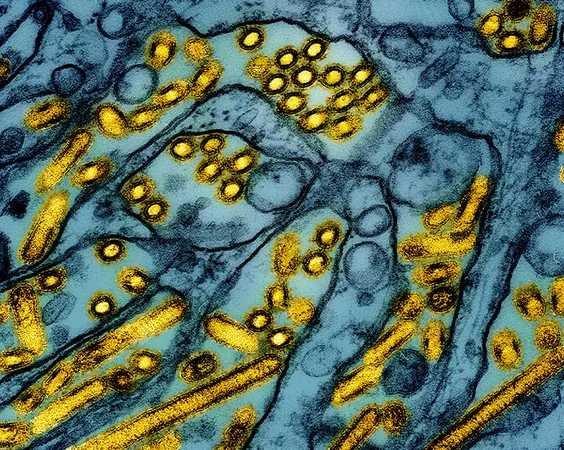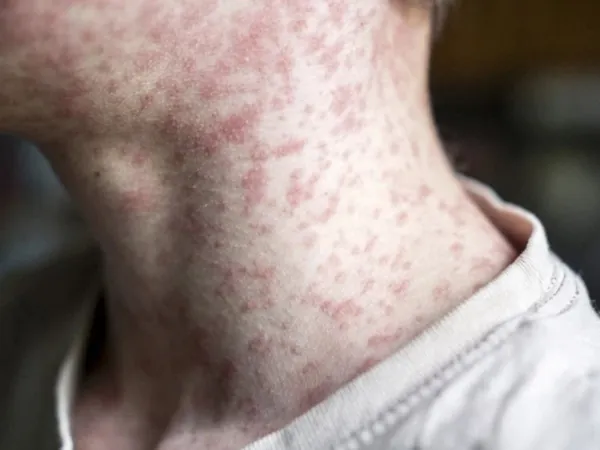
Is the Bird Flu Crisis Getting More Serious? Here's What You Need to Know!
2025-01-14
Author: Olivia
The spread of Bird Flu, primarily the H5N1 strain, is raising alarms across the United States as it reaches unprecedented levels and displays unusual behavior.
Just last week, the nation mourned the loss of a Louisiana resident—the first human to die from the H5N1 virus in the U.S.—after being hospitalized with severe symptoms. This individual, over the age of 65 and suffering from underlying health conditions, reportedly contracted the virus through contact with both wild birds and a local flock of chickens, according to the Louisiana Department of Health.
While health experts emphasize that the general public is still considered to be at low risk, they admit that the rapid infection rate of H5N1 among wild birds, domestic poultry, and mammals—including cows and even humans—raises critical concerns. If this virus mutates in a way that facilitates human-to-human transmission, it could lead to an epidemic or even a global pandemic.
Dr. Meghan Davis, a noted researcher and molecular epidemiologist at Johns Hopkins, stated, "At this point, we’ve seen no evidence of human-to-human transmission, but mutations could pose future risks."
Why the Growing Concern?
The primary concern arises from H5N1's unusual persistence compared to previous avian flu strains. This year saw an unexpected twist when the virus infected dairy cows, which is atypical for avian flu. The H5N1 strain primarily infects the mammary glands in cows, leading to worries over the safety of milk consumption. This infectious behavior extends to wide-ranging mammals, including foxes, bears, and even domestic cats, heightening the risk of cross-species transmission.
Experts have reported alarming marine mammal deaths in South America connected to H5N1, suggesting a broader ecological impact.
Symptoms and Severity of H5N1
When contracted from wild birds or poultry, H5N1 typically leads to severe respiratory issues, mirroring older, more deadly strains of avian influenza, which historically carried a fatality rate around 50% in humans. In contrast, individuals exposed to the virus through infected cows generally experience milder symptoms akin to a seasonal flu, including upper respiratory issues and conjunctivitis—particularly among dairy workers who may come into contact with infected milk.
Researchers speculate that the differences in symptoms are due to the particular H5N1 genotype individuals are exposed to—wild birds carrying a more virulent strain compared to dairy farm-related infections.
The Human-to-Human Transmission Threat
Animal-to-animal transmission is being closely monitored. Dairy farms have recorded consecutive cases of H5N1 among cows, which could suggest a potential $1 million risk of the virus adapting to human hosts. With every case, the opportunities for mutations increase, raising fears about future human-to-human transmission.
What Would it Take for a Pandemic?
The worst-case scenario involves a person being co-infected with H5N1 and another strain of influenza, like a seasonal flu, creating an ideal environment for dangerous mutations. If that happens, we risk triggering a pandemic.
Tracking the Outbreak
States typically lead case management, supplemented by federal agencies such as the USDA and CDC. Recent data suggests approximately 66 human cases and 900 infected dairy herds, but experts caution that this is just the tip of the iceberg. People working in agriculture may not always have adequate healthcare access, limiting overall case reporting and surveillance.
How to Protect Yourself and Your Pets
Although the general public faces a low risk, precautionary measures are essential. Avoid consuming raw milk and undercooked meat, and steer clear of touching dead or visibly sick birds and mammals. Pet owners should exercise additional caution since various pets, particularly cats, are vulnerable to H5N1, potentially contracting it through contaminated raw products or direct exposure to wild birds.
To minimize risks for your pets, keep cats indoors and ensure dogs avoid areas frequented by migratory waterfowl. If your pet has been exposed, consult with a veterinarian and use pet-safe disinfectants to clean them appropriately.
Conclusion
As experts continue to track H5N1 and its potential impacts, staying informed and cautious is paramount. Understanding the nature of this virus and its mutations can help reduce personal and community health risks. Be vigilant, follow health guidelines, and share this information to keep your loved ones safe!









 Brasil (PT)
Brasil (PT)
 Canada (EN)
Canada (EN)
 Chile (ES)
Chile (ES)
 Česko (CS)
Česko (CS)
 대한민국 (KO)
대한민국 (KO)
 España (ES)
España (ES)
 France (FR)
France (FR)
 Hong Kong (EN)
Hong Kong (EN)
 Italia (IT)
Italia (IT)
 日本 (JA)
日本 (JA)
 Magyarország (HU)
Magyarország (HU)
 Norge (NO)
Norge (NO)
 Polska (PL)
Polska (PL)
 Schweiz (DE)
Schweiz (DE)
 Singapore (EN)
Singapore (EN)
 Sverige (SV)
Sverige (SV)
 Suomi (FI)
Suomi (FI)
 Türkiye (TR)
Türkiye (TR)
 الإمارات العربية المتحدة (AR)
الإمارات العربية المتحدة (AR)